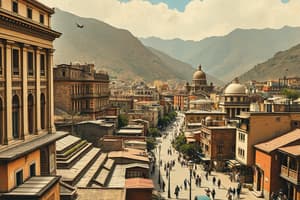Podcast
Questions and Answers
What percentage of Colombia's territory does the Andean region cover?
What percentage of Colombia's territory does the Andean region cover?
- 24%
- 30%
- 27% (correct)
- 20%
Where is the Andean region located in Colombia?
Where is the Andean region located in Colombia?
- Central part of Colombia (correct)
- Southwest part of Colombia
- Northwest part of Colombia
- Northeast part of Colombia
What is the main economic driver of the Andean region?
What is the main economic driver of the Andean region?
- Livestock
- Agriculture (correct)
- Manufacturing
- Tourism
What is the estimated population of the Andean region?
What is the estimated population of the Andean region?
What is the Andean region known for in terms of biodiversity?
What is the Andean region known for in terms of biodiversity?
What type of climate zones can be found in the Andean region?
What type of climate zones can be found in the Andean region?
What type of natural resources can be found in the Andean region?
What type of natural resources can be found in the Andean region?
What is the Coffee Axis?
What is the Coffee Axis?
Which of the following mountain ranges is part of the Andean region?
Which of the following mountain ranges is part of the Andean region?
Which of the following rivers is not mentioned in the Andean region?
Which of the following rivers is not mentioned in the Andean region?
How many departments are part of the Andean region?
How many departments are part of the Andean region?
Which of the following festivals is not mentioned in the Andean region?
Which of the following festivals is not mentioned in the Andean region?
Which of the following traditional dishes is not mentioned in the Andean region?
Which of the following traditional dishes is not mentioned in the Andean region?
Which of the following cities is not mentioned as part of the Andean region?
Which of the following cities is not mentioned as part of the Andean region?
Flashcards are hidden until you start studying
Study Notes
The Andean Region of Colombia
- The Andean region is a natural region in Colombia that covers around 27% of the country's territory.
- It is characterized by its mountainous formations, biodiversity, fertile valleys, and rich cultural heritage.
- The region is one of the most humid areas in South America, with exuberant landscapes and an abundance of natural resources.
Location and Limits
- The Andean region is located in the central part of Colombia, but it stretches from the southwest to the northeast, forming a mountainous system.
- It borders the Caribbean region to the north, Ecuador to the south, the Orinoquía region to the east, and the Pacific region to the west.
- It also shares borders with Venezuela to the northeast and the Amazon region to the southeast.
Characteristics
- The Andean region is the most populated region in Colombia, with over 75% of the country's population, approximately 26 million people.
- It covers an area of around 282,540 square kilometers, which is around 24% of the country's total territory.
- The region has a diverse climate, with different zones having different climate conditions, including tropical, subtropical, and temperate zones.
Biodiversity
- The Andean region is home to a vast array of flora and fauna, with four main groups of vegetation: ecuatorial, sub-Andean, Andean, and páramo.
- The region is known for its richness in species, including orchids, and trees such as oak, cedar, and others.
- It is also home to a diverse range of wildlife, including monkeys, deer, and birds.
Economy
- The main economic driver of the region is agriculture, particularly coffee production, which is concentrated in the Coffee Axis.
- The region is also rich in natural resources, including oil, coal, and minerals.
- Other important economic activities in the region include tourism, livestock, and manufacturing.
Hydrography
- The Andean region is rich in water resources, with many rivers and streams, including the Cauca and Magdalena rivers.
- The region has an abundance of freshwater, with many rivers and streams flowing from the Andean mountains to the surrounding regions.
Relief
- The Andean region is formed by three main mountain ranges: the Cordillera Oriental, the Cordillera Central, and the Cordillera Occidental.
- The region has many peaks, including the Nevado del Quindío, the Nevado del Tolima, and the Ritacuba Blanco.
Departments and Cities
- The Andean region is comprised of 10 departments: Antioquia, Boyacá, Caldas, Cundinamarca, Huila, Norte de Santander, Quindío, Risaralda, Santander, and Tolima.
- Each department has its own unique characteristics, with many cities and towns, including Medellín, Manizales, Bogotá, and others.
Culture
- The Andean region has a rich cultural heritage, with many traditions and festivals, including the Feria de las Flores in Medellín and the Feria de Manizales.
- The region has a diverse range of music, including the bambuco, the torbellino, and the guabina, among others.
- The region is also known for its gastronomy, with many traditional dishes, including the bandeja paisa, ajiaco, and others.
Traditions and Festivals
- The region has many traditions and festivals, including the Romerías de San Juan and San Pedro, and the Fiestas de la Vendimia.
- The region is also known for its traditional music and dance, including the bambuco, the torbellino, and the guabina, among others.
The Andean Region of Colombia
- Covers 27% of Colombia's territory, characterized by mountainous formations, biodiversity, fertile valleys, and rich cultural heritage.
Location and Limits
- Located in central Colombia, stretching from southwest to northeast, forming a mountainous system.
- Borders the Caribbean region to the north, Ecuador to the south, the Orinoquía region to the east, and the Pacific region to the west.
- Shares borders with Venezuela to the northeast and the Amazon region to the southeast.
Characteristics
- Most populated region in Colombia, with over 75% of the country's population, approximately 26 million people.
- Covers an area of around 282,540 square kilometers, which is around 24% of the country's total territory.
- Diverse climate, with different zones having different climate conditions, including tropical, subtropical, and temperate zones.
Biodiversity
- Home to a vast array of flora and fauna, with four main groups of vegetation: ecuatorial, sub-Andean, Andean, and páramo.
- Rich in species, including orchids, oak, cedar, and other trees.
- Diverse range of wildlife, including monkeys, deer, and birds.
Economy
- Main economic driver is agriculture, particularly coffee production, concentrated in the Coffee Axis.
- Rich in natural resources, including oil, coal, and minerals.
- Other important economic activities include tourism, livestock, and manufacturing.
Hydrography
- Rich in water resources, with many rivers and streams, including the Cauca and Magdalena rivers.
- Abundance of freshwater, with many rivers and streams flowing from the Andean mountains to the surrounding regions.
Relief
- Formed by three main mountain ranges: the Cordillera Oriental, the Cordillera Central, and the Cordillera Occidental.
- Many peaks, including the Nevado del Quindío, the Nevado del Tolima, and the Ritacuba Blanco.
Departments and Cities
- Comprised of 10 departments: Antioquia, Boyacá, Caldas, Cundinamarca, Huila, Norte de Santander, Quindío, Risaralda, Santander, and Tolima.
- Each department has its own unique characteristics, with many cities and towns, including Medellín, Manizales, Bogotá, and others.
Culture
- Rich cultural heritage, with many traditions and festivals, including the Feria de las Flores in Medellín and the Feria de Manizales.
- Diverse range of music, including the bambuco, the torbellino, and the guabina, among others.
- Known for its gastronomy, with many traditional dishes, including the bandeja paisa, ajiaco, and others.
Traditions and Festivals
- Many traditions and festivals, including the Romerías de San Juan and San Pedro, and the Fiestas de la Vendimia.
- Known for its traditional music and dance, including the bambuco, the torbellino, and the guabina, among others.
Studying That Suits You
Use AI to generate personalized quizzes and flashcards to suit your learning preferences.



